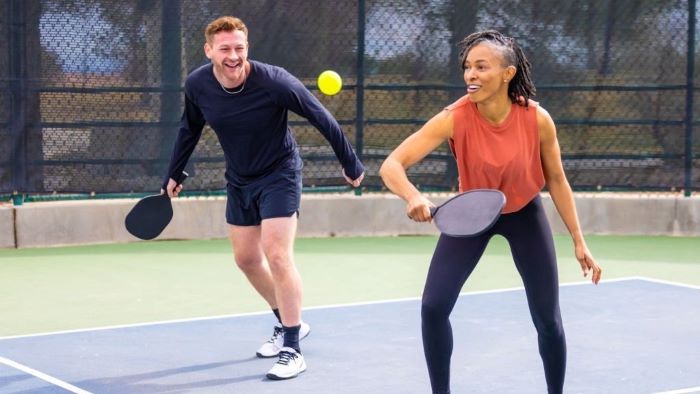If you are a pickleball enthusiast, you might have heard of the term “split step” and wondered what it means and how to do it. In this article, we will answer all your questions about this essential footwork technique that can take your game to the next level.

Read on to learn about the split step, why it is important, how to perform it, when to use it, and how to practice it.
So, let’s dive into the details!
What Is the Split Step in Pickleball?
Pickleball’s split step is a fundamental movement that helps you prepare for any incoming shot from your opponent.
The move involves jumping off the ground and landing on the balls of your feet while keeping your knees bent. This way, you are balanced and ready to move in any direction quickly and efficiently.
The split step is similar to other athletes’ movements, such as boxers, soccer players, and basketball players. It allows you to react faster and better to your opponents’ actions and gives you an advantage over them.
The split step is crucial in pickleball because the ball travels fast and bounces low. This requires you to constantly move quickly and adjust your position.
The split step is not difficult, but it requires practice and consistency to master. By incorporating the split step into your pickleball game, you can improve your performance and enjoy the sport more.
Why Is the Split Step Important in Pickleball?
Pickleball’s split step allows you to react faster and better to your opponent’s shots. By landing on the balls of your feet, you can push off and explode toward the ball with more power and control.

A bending knee lowers your center of gravity and improves your stability. By keeping your feet shoulder-width apart, you can avoid crossing your legs or taking unnecessary steps that can slow you down or cause you to lose balance.
The split step also helps you avoid injuries and fatigue by reducing the impact on your joints and muscles. You can absorb some of the shock from landing by hopping slightly off the ground and prevent stress fractures or sprains.
By keeping your knees bent, you can protect your ligaments and tendons from tearing or stretching. You can avoid twisting or rolling your ankles by keeping your feet shoulder-width apart.
How to Perform the Split Step?
To perform the split step correctly, follow these steps:
- Your feet should be shoulder-width apart and your knees bent.
- Watch your opponent’s paddle and anticipate their shot direction.
- As they hit the ball, quickly hop up and down, landing with your feet shoulder-width apart.
- Keep your knees bent and your weight centered on your feet.
- Be ready to move in any direction.
When Should You Split Step?
You should split-step every time your opponent is about to contact the ball. The timing of the split step is crucial.
You want to start your hop as your opponent winds up to hit the ball. You want to be back on the ground after they make contact and you figure out where they directed the ball. When your opponent makes contact with you, you should be at the top of your hop.

In doubles, many players make the mistake of rushing from the baseline to the non-volley line in one sprint and being caught off guard by their opponents’ shots.
Instead, it is better to take 2-3 split steps as you reach the net, stopping briefly each time your opponent hits the ball. This way, you are always ready and can adjust to any situation.
How to Practice the Split Step?
The most effective way to practice the split step is with a partner or a wall. You can start by tossing or hitting balls back and forth slowly and focusing on executing the split step correctly each time.
As you get more comfortable, you can increase the speed and intensity of the rally and vary the direction and spin of the balls. You can also incorporate other footwork skills, such as lateral movement, crossover steps, and pivots.
Another way to practice the split step is to watch videos of professional pickleball players and observe how they use it in different situations. You can also record yourself playing pickleball and analyze how well you perform the split step and what areas to improve.
FAQs
The slide step in pickleball is a variation of the split step that involves sliding your feet slightly apart instead of hopping off the ground. It reduces the impact on your knees and ankles and maintains a low center of gravity. The slide step is beneficial on slippery or uneven surfaces.
You can step in when serving in pickleball if you do not cross the baseline or the imaginary extension of the sideline. This is before you contact the ball. You can also step in after hitting the ball, as long as you do not touch the non-volley zone or line.
You cannot step into the non-volley zone or the non-volley zone line in pickleball when you hit a volley, a shot in the air before it bounces. If you do, it is a fault, and you lose the point. You can step into the non-volley zone or the non-volley zone line after hitting a volley, as long as you do not touch the net or any part of it.
Well, It’s a Wrap!
We hope this article has quenched your curiosity about the pickleball split step and inspired you to try it out on the court.
The split step is a simple but powerful technique that can improve your reaction time, balance, power, control, stability, injury prevention, and fatigue resistance. By mastering this skill, you can elevate your pickleball game and have more fun playing this amazing sport.
If you enjoyed this article, please share it with your friends and fellow pickleball players. Also, subscribe to our blog for more tips and tricks on playing pickleball like a pro!
Happy pickleballing!🏓

I am a professional physiotherapist and the author of the BallSportsPro. I worked with athletes of all levels, from amateur to professional, and i helped them overcome injuries and improve their performance. I am a certified Pickleball instructor and has been playing the sport for over 10 years.




